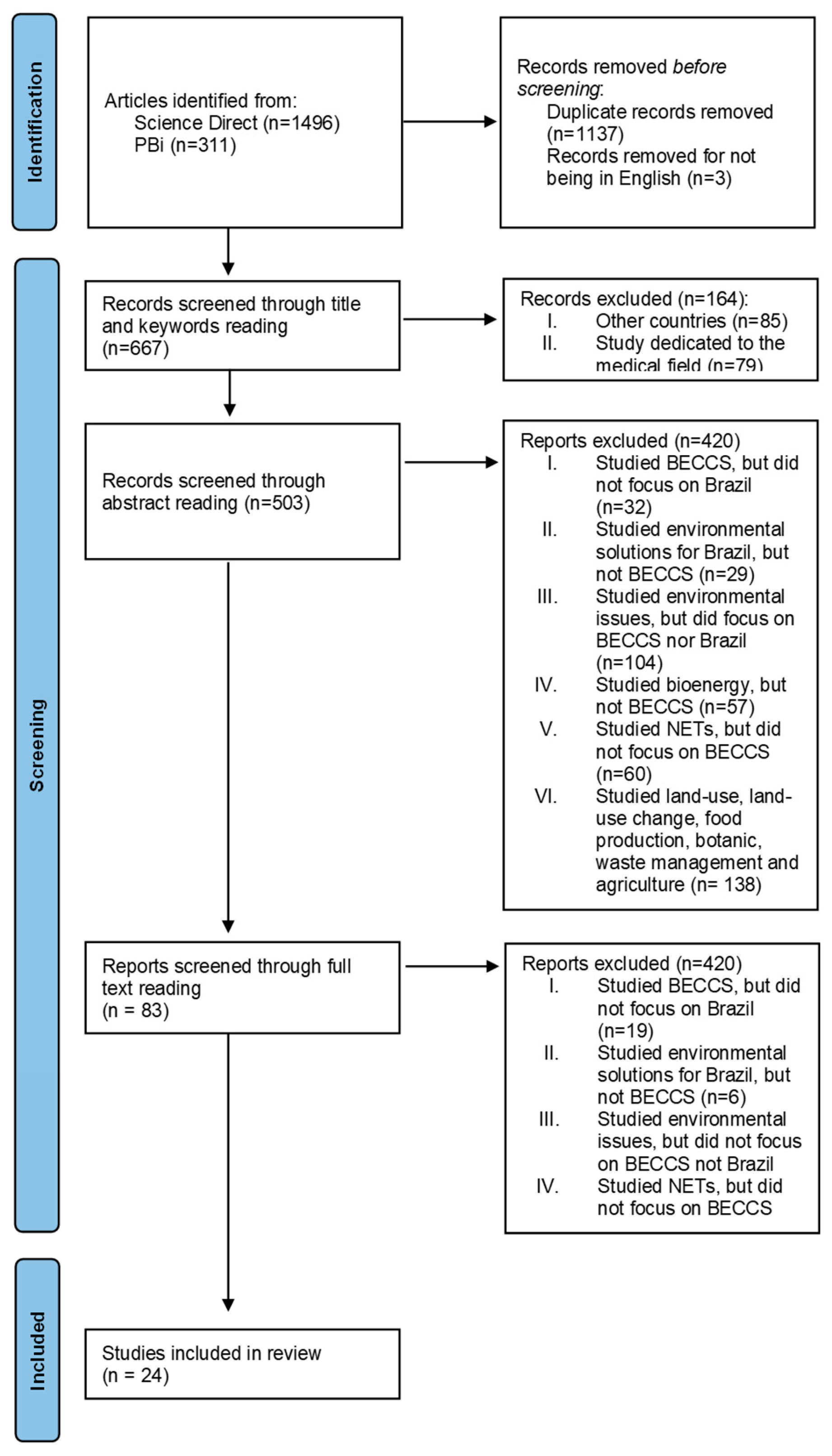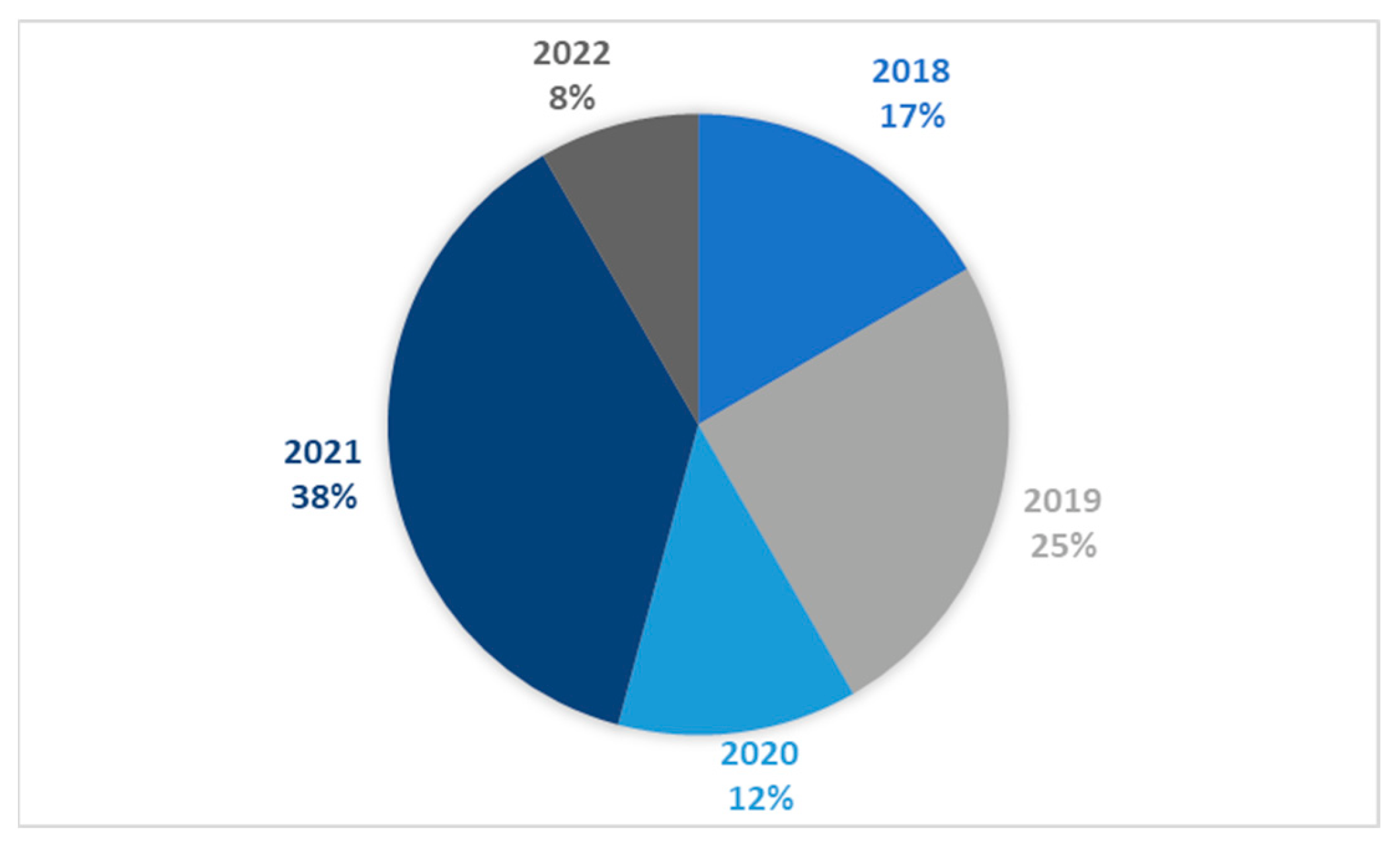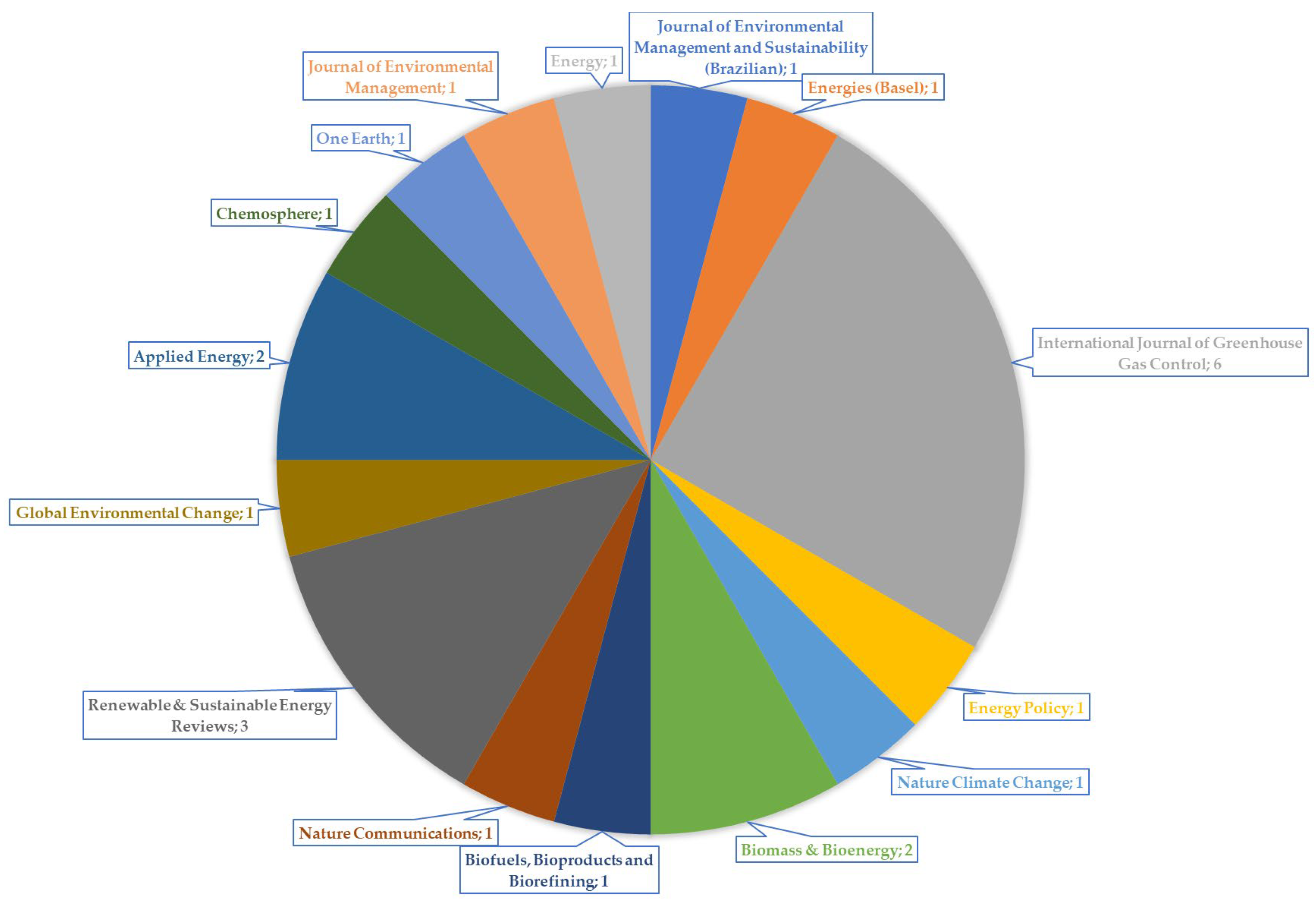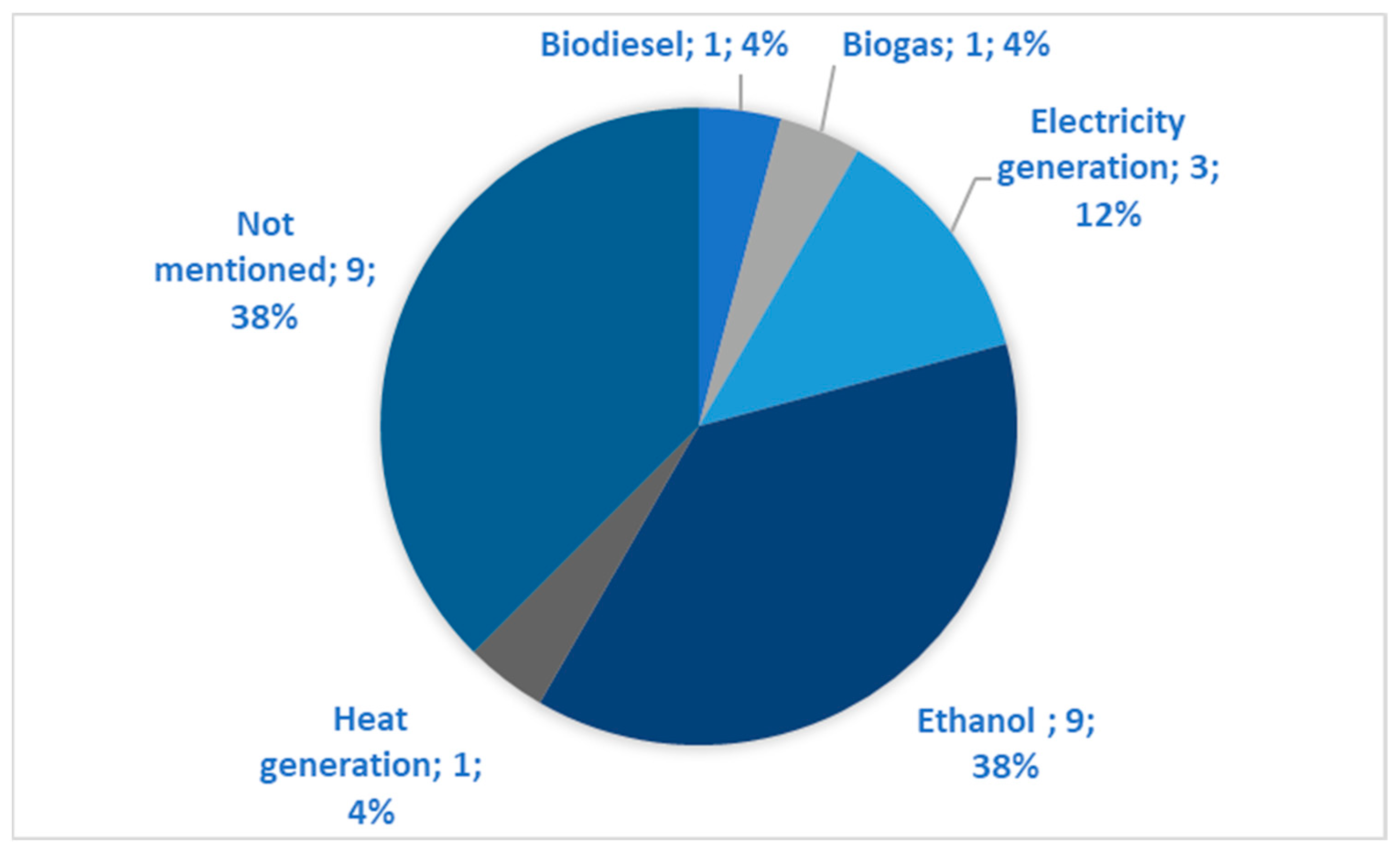Bioenergy with Carbon Capture and Storage (BECCS) in Brazil: A Review
Abstract
1. Introduction
2. Materials and Methods
2.1. Definition of the Research Question
2.2. Application of Boolean Connectors
2.3. Definition of the Database and Search Criteria
2.4. Definition of the Database and Search Criteria
3. Results
3.1. Introduction to Findings
3.2. General Aspects of Included Articles
3.3. Technical, Economic, and Emissions Assessments of Developing BECCS in Brazil
3.3.1. Simulation of BECCS Connected to Ethanol Plants, and CHP Units in Ethanol Distilleries
3.3.2. Simulation of BECCS Connected to Biodiesel Plants
3.3.3. Simulation of BECCS Connected to Electricity Generation Plants, except CHP Units in Ethanol Distilleries
3.3.4. Simulation of BECCS Connected to Industrial Processes
3.4. Biomass Availability as the Greatest Endowment of Brazil for BECCS Implementation
3.5. Importance of Implementing BECCS in Brazil for World-Wide Mitigation Targets
3.6. Potential Impacts on Food and Land Competition and Availability
3.7. Aspects of CO2 Transportation for BECCS Implementation
3.8. Brazilian Regulatory Efforts towards CCS, CCUS and BECCS
4. Discussion
4.1. CO2 Mitigation Potential of BECCS in Brazil
| Article | Summary of the Article’s Content | Mitigation Results Found |
|---|---|---|
| Neto et al. [31] | Simulation of a calcium looping (CaL) carbon capture process, and an amine-based carbon capture process, to a mid-south Brazilian cogeneration plant fueled with sugarcane bagasse. | CaL carbon capture process: captures 188 tCO2/h. Amine-based carbon capture process: captures 97 tCO2/h. |
| Carminati et al. [34] | Simulate the carbon capture during the fermentation and the bagasse combustion stages, in a conventional large-scale sugarcane-biorefinery | 781.0 kgCO2eq negative emission per ton of sugarcane, and a total of 5.22 MtCO2Eq/year drained from the atmosphere. |
| Milão et al. [37] | Simulate the carbon capture during the fermentation stage in a large-scale sugarcane-ethanol-biorefinery in Brazil. | 633.34 tCO2/h could be captured, resulting in a negative emissions capacity of 5.1 × 106 tCO2/year. |
| Tagomori et al. [38] | Apply georeferenced and process analysis to estimate the potential of producing diesel biofuel based on forestry residues in Brazil. | When using eucalyptus as feedstock: potential of capturing 184.9tCO2/h. When using pine as feedstock: potential of capturing 191.6 tCO2/h. Total mitigation potential of nearly 25 MtCO2/year. |
| Poblete et al. [39] | Simulate a carbon capture and storage complex in a biogas platn sourced by sewage-water and sewage-sludge. | Removal of 5.98 kgCO2 for each ton of reusable water produced. Removal of 0.76 tons of CO2 per MWh exported to the electricity grid. |
| Asibor et al. [43] | Discuss the deployment of carbon dioxide removal technologies (CDR) in different countries, based on responsibility, capability, and requirement. | Brazil shows a potential of cumulative removal of 3.60 GtCO2 through BECCS. |
4.2. Highlighted Industries in the Review
4.3. Economic Viability
4.4. Gaps Identified in the Literature
4.5. This Article’s Limitations
5. Conclusions
Funding
Acknowledgments
Conflicts of Interest
References
- Rogelj, J.; Shindell, D.; Jiang, K.; Fifita, S.; Forster, P.; Ginzburg, V.; Handa, C.; Kheshgi, H.; Kobayashi, S.; Kriegler, E.; et al. Mitigation Pathways Compatible with 1.5 °C in the Context of Sustainable Development; IPCC: Geneva, Switzerland, 2018. [Google Scholar]
- Brazil. Paris Agreement: Brazil’s Nationally Determined Contribution (NDC) (Updated Submission); United Nations Climate Change. 2020. Available online: https://www4.unfccc.int/sites/NDCStaging/Pages/Party.aspx?party=BRA (accessed on 3 February 2022).
- Ketzer, J.M.M.; Machado, C.X.; Rockett, G.C.; Iglesias, R.S. Atlas Brasileiro de Captura e Armazenamento Geológico de CO2; Pontífica Universidade Católica do Rio Grande do Sul: Porto Alegre, Brazil, 2016; ISBN 9788539707652. [Google Scholar]
- Silveira, B.H.M.; Costa, H.K.M.; Santos, E.M. O benefício do RenovaBio para o mercado de BECCS no Brasil. In Proceedings of the Rio Oil & Gas Expo and Conference, Rio de Janeiro, RJ, Brazil, 26–29 September 2022; Brazilian Petroleum and Gas Institute—IBP: Rio de Janeiro, Brazil, 2022. ISBN 2525-7579. [Google Scholar]
- Kemper, J. Biomass and carbon dioxide capture and storage: A review. Int. J. Greenh. Gas Control 2015, 40, 401–430. [Google Scholar] [CrossRef]
- Consoli, C. Bioenergy and Carbon Capture and Storage; Global CCS Institute: Melbourne, Australia, 2019; pp. 1–14. [Google Scholar]
- de Souza, J.F.T.; Pacca, S.A. How far can low-carbon energy scenarios reach based on proven technologies? Mitig. Adapt. Strateg. Glob. Chang. 2019, 24, 687–705. [Google Scholar] [CrossRef]
- Babin, A.; Vaneeckhaute, C.; Iliuta, M.C. Potential and challenges of bioenergy with carbon capture and storage as a carbon-negative energy source: A review. Biomass Bioenergy 2021, 146, 105968. [Google Scholar] [CrossRef]
- Stavrakas, V.; Spyridaki, N.A.; Flamos, A. Striving towards the deployment of bio-energy with carbon capture and storage (BECCS): A review of research priorities and assessment needs. Sustainability 2018, 10, 2206. [Google Scholar] [CrossRef]
- Ricci, O. Providing adequate economic incentives for bioenergies with CO2 capture and geological storage. Energy Policy 2012, 44, 362–373. [Google Scholar] [CrossRef]
- IEA. Five Keys to Unlock CCS Investment; IEA: Paris, France, 2018. [Google Scholar]
- Daioglou, V.; Doelman, J.C.; Wicke, B.; Faaij, A.; van Vuuren, D.P. Integrated assessment of biomass supply and demand in climate change mitigation scenarios. Glob. Environ. Change 2019, 54, 88–101. [Google Scholar] [CrossRef]
- Köberle, A.C.; Rochedo, P.R.R.; Lucena, A.F.P.; Szklo, A.; Schaeffer, R. Brazil’s emission trajectories in a well-below 2 °C world: The role of disruptive technologies versus land-based mitigation in an already low-emission energy system. Clim. Change 2020, 162, 1823–1842. [Google Scholar] [CrossRef]
- Köberle, A.C.; Daioglou, V.; Rochedo, P.; Lucena, A.F.P.; Szklo, A.; Fujimori, S.; Brunelle, T.; Kato, E.; Kitous, A.; van Vuuren, D.P.; et al. Can Global Models Provide Insights into Regional Mitigation Strategies? A Diagnostic Model Comparison Study of Bioenergy in Brazil; Springer: Cham, Switzerland, 2022; Volume 170, ISBN 0123456789. [Google Scholar]
- Hayman, G.D.; Comyn-Platt, E.; Huntingford, C.; Harper, A.B.; Powell, T.; Cox, P.M.; Collins, W.; Webber, C.; Lowe, J.; Sitch, S.; et al. Regional variation in the effectiveness of methane-based and land-based climate mitigation options. Earth Syst. Dyn. 2021, 12, 513–544. [Google Scholar] [CrossRef]
- Moreira, J.R.; Romeiro, V.; Fuss, S.; Kraxner, F.; Pacca, S.A. BECCS potential in Brazil: Achieving negative emissions in ethanol and electricity production based on sugar cane bagasse and other residues. Appl. Energy 2016, 179, 55–63. [Google Scholar] [CrossRef]
- Rochedo, P.R.R.; Costa, I.V.L.; Império, M.; Hoffmann, B.S.; Merschmann, P.R.D.C.; Oliveira, C.C.N.; Szklo, A.; Schaeffer, R. Carbon capture potential and costs in Brazil. J. Clean. Prod. 2016, 131, 280–295. [Google Scholar] [CrossRef]
- Poblete, I.B.S.; Ofélia de Queiroz, F.A.; de Medeiros, J.L. Dynamic analysis of sustainable biogas-combined-cycle plant: Time-varying demand and bioenergy with carbon capture and storage. Renew. Sustain. Energy Rev. 2020, 131, 109997. [Google Scholar] [CrossRef]
- Nogueira, T.; Rochedo, P.R.R.; Szklo, A. Evaluation of offshore CO2 transport alternatives in Brazil. Int. J. Greenh. Gas Control 2022, 116, 103629. [Google Scholar] [CrossRef]
- Arlota, C.; Costa, H.K.d.M. Who is taking climate change seriously? Evidence based on a comparative analysis of the carbon capture and storage national legal framework in Brazil, Canada, the European Union, and the United States. In Carbon Capture and Storage in International Energy Policy and Law; Costa, H.K.M., Arlota, C., Eds.; Elsevier: Amsterdam, The Netherlands, 2021; pp. 235–246. ISBN 9780323852500. [Google Scholar]
- Watson, J.; Broad, O.; Butnar, I. A Policy Framework for Bioenergy with Carbon Capture and Storage (BECCS). In Together for Climate Action—Campaign for Net Zero; UCL Institute of Sustainable Resources: London, UK, 2021; p. 7. [Google Scholar]
- Galvão, T.F.; Pereira, M.G. Revisões sistemáticas da literatura: Passos para sua elaboração. Epidemiol. Serviços Saúde 2014, 23, 183–184. [Google Scholar] [CrossRef]
- McAndrew, R.; Mulcahy, R.; Gordon, R.; Russell-Bennett, R. Household energy efficiency interventions: A systematic literature review. Energy Policy 2021, 150, 112136. [Google Scholar] [CrossRef]
- Teixeira, A.C.R.; Machado, P.G.; Collaço, F.M.d.A.; Mouette, D. Alternative fuel technologies emissions for road heavy-duty trucks: A review. Environ. Sci. Pollut. Res. 2021, 28, 20954–20969. [Google Scholar] [CrossRef]
- Sorrel, S. Improving the evidence base for energy policy: The role of systematic reviews. Energy Policy 2007, 35, 1858–1871. [Google Scholar] [CrossRef]
- Galvão, M.C.B.; Ricarte, I.L.M. Systematic literature review: Concept, production and publication. Logeion Filos. Inf. 2019, 6, 57–73. [Google Scholar] [CrossRef]
- Relva, S.G.; da Silva, V.O.; Gimenes, A.L.V.; Udaeta, M.E.M.; Ashworth, P.; Peyerl, D. Enhancing developing countries’ transition to a low-carbon electricity sector. Energy 2021, 220, 119659. [Google Scholar] [CrossRef]
- Page, M.J.; Moher, D.; Bossuyt, P.M.; Boutron, I.; Hoffmann, T.C.; Mulrow, C.D.; Shamseer, L.; Tetzlaff, J.M.; Akl, E.A.; Brennan, S.E.; et al. PRISMA 2020 explanation and elaboration: Updated guidance and exemplars for reporting systematic reviews. BMJ 2021, 372, n160. [Google Scholar] [CrossRef] [PubMed]
- Shamseer, L.; Moher, D.; Clarke, M.; Ghersi, D.; Liberati, A.; Petticrew, M.; Shekelle, P.; Stewart, L.A.; Altman, D.G.; Booth, A.; et al. Preferred reporting items for systematic review and meta-analysis protocols (prisma-p) 2015: Elaboration and explanation. BMJ 2015, 349, g7647. [Google Scholar] [CrossRef]
- da Cruz, T.T.; Perrella Balestieri, J.A.; de Toledo Silva, J.M.; Vilanova, M.R.N.; Oliveira, O.J.; Ávila, I. Life cycle assessment of carbon capture and storage/utilization: From current state to future research directions and opportunities. Int. J. Greenh. Gas Control 2021, 108, 103309. [Google Scholar] [CrossRef]
- Neto, S.; Szklo, A.; Rochedo, P.R.R. Calcium looping post-combustion CO2 capture in sugarcane bagasse fuelled power plants. Int. J. Greenh. Gas Control 2021, 110, 103401. [Google Scholar] [CrossRef]
- Bressanin, J.M.; Guimarães, H.R.; Chagas, M.F.; Sampaio, I.L.d.M.; Klein, B.C.; Watanabe, M.D.B.; Bonomi, A.; de Morais, E.R.; Cavalett, O. Advanced technologies for electricity production in the sugarcane value chain are a strategic option in a carbon reward policy context. Energy Policy 2021, 159, 112637. [Google Scholar] [CrossRef]
- Wiesberg, I.L.; de Medeiros, J.L.; de Mello, R.V.P.; Maia, J.G.S.; Bastos, J.B.V.; Araújo, O.D.d.F. Bioenergy production from sugarcane bagasse with carbon capture and storage: Surrogate models for techno-economic decisions. Renew. Sustain. Energy Rev. 2021, 150, 111486. [Google Scholar] [CrossRef]
- Carminati, H.B.; Milão, R.d.F.D.; de Medeiros, J.L.; Araújo, O.d.Q.F. Bioenergy and full carbon dioxide sinking in sugarcane-biorefinery with post-combustion capture and storage: Techno-economic feasibility. Appl. Energy 2019, 254, 113633. [Google Scholar] [CrossRef]
- Milão, R.d.F.D.; Carminati, H.B.; Araújo, O.d.Q.F.; de Medeiros, J.L. Thermodynamic, financial and resource assessments of a large-scale sugarcane-biorefinery: Prelude of full bioenergy carbon capture and storage scenario. Renew. Sustain. Energy Rev. 2019, 113, 109251. [Google Scholar] [CrossRef]
- Restrepo-Valencia, S.; Walter, A. Techno-economic assessment of bio-energy with carbon capture and storage systems in a typical sugarcane mill in Brazil. Energies 2019, 12, 1129. [Google Scholar] [CrossRef]
- Milão, R.d.F.D.; Araújo, O.d.Q.F.; de Medeiros, J.L. Second Law analysis of large-scale sugarcane-ethanol biorefineries with alternative distillation schemes: Bioenergy carbon capture scenario. Renew. Sustain. Energy Rev. 2021, 135, 110181. [Google Scholar] [CrossRef]
- Tagomori, I.S.; Rochedo, P.R.R.; Szklo, A. Techno-economic and georeferenced analysis of forestry residues-based Fischer-Tropsch diesel with carbon capture in Brazil. Biomass Bioenergy 2019, 123, 134–148. [Google Scholar] [CrossRef]
- Poblete, I.B.S.; Araújo, O.d.Q.F.; de Medeiros, J.L. Sewage-water treatment with bio-energy production and carbon capture and storage. Chemosphere 2022, 286, 131763. [Google Scholar] [CrossRef]
- Tanzer, S.E.; Blok, K.; Ramírez, A. Can bioenergy with carbon capture and storage result in carbon negative steel? Int. J. Greenh. Gas Control 2020, 100, 103104. [Google Scholar] [CrossRef]
- van Soest, H.L.; den Elzen, M.G.J.; van Vuuren, D.P. Net-zero emission targets for major emitting countries consistent with the Paris Agreement. Nat. Commun. 2021, 12, 2140. [Google Scholar] [CrossRef] [PubMed]
- Mantulet, G.; Bidaud, A.; Mima, S. The role of biomass gasification and methanisation in the decarbonisation strategies. Energy 2020, 193, 116737. [Google Scholar] [CrossRef]
- Asibor, J.O.; Clough, P.T.; Nabavi, S.A.; Manovic, V. A country-level assessment of the deployment potential of greenhouse gas removal technologies. J. Environ. Manage. 2022, 323, 116211. [Google Scholar] [CrossRef] [PubMed]
- Morris, J.; Farrell, J.; Kheshgi, H.; Thomann, H.; Chen, H.; Paltsev, S.; Herzog, H. Representing the costs of low-carbon power generation in multi-region multi-sector energy-economic models. Int. J. Greenh. Gas Control 2019, 87, 170–187. [Google Scholar] [CrossRef]
- Fajardy, M.; Mac Dowell, N. Recognizing the Value of Collaboration in Delivering Carbon Dioxide Removal. One Earth 2020, 3, 214–225. [Google Scholar] [CrossRef]
- Lap, T.; Benders, R.; Köberle, A.; van der Hilst, F.; Nogueira, L.; Szklo, A.; Schaeffer, R.; Faaij, A. Pathways for a Brazilian biobased economy: Towards optimal utilization of biomass. Biofuels, Bioprod. Biorefining 2019, 13, 673–689. [Google Scholar] [CrossRef]
- Wei, Y.M.; Kang, J.N.; Liu, L.C.; Li, Q.; Wang, P.T.; Hou, J.J.; Liang, Q.M.; Liao, H.; Huang, S.F.; Yu, B. A proposed global layout of carbon capture and storage in line with a 2 °C climate target. Nat. Clim. Change 2021, 11, 112–118. [Google Scholar] [CrossRef]
- Audoly, R.; Vogt-Schilb, A.; Guivarch, C.; Pfeiffer, A. Pathways toward zero-carbon electricity required for climate stabilization. Appl. Energy 2018, 225, 884–901. [Google Scholar] [CrossRef]
- Doelman, J.C.; Stehfest, E.; Tabeau, A.; van Meijl, H.; Lassaletta, L.; Gernaat, D.E.H.J.; Neumann-Hermans, K.; Harmsen, M.; Daioglou, V.; Biemans, H.; et al. Exploring SSP land-use dynamics using the IMAGE model: Regional and gridded scenarios of land-use change and land-based climate change mitigation. Glob. Environ. Change 2018, 48, 119–135. [Google Scholar] [CrossRef]
- da Silva, F.T.F.; Carvalho, F.M.; Corrêa, J.L.G., Jr.; Merschmann, P.R.d.C.; Tagomori, I.S.; Szklo, A.; Schaeffer, R. CO2 capture in ethanol distilleries in Brazil: Designing the optimum carbon transportation network by integrating hubs, pipelines and trucks. Int. J. Greenh. Gas Control 2018, 71, 168–183. [Google Scholar] [CrossRef]
- Tagomori, I.S.; Carvalho, F.M.; da Silva, F.T.F.; Merschmann, P.R.d.C.; Rochedo, P.R.R.; Szklo, A.; Schae, R. Designing an optimum carbon capture and transportation network by integrating ethanol distilleries with fossil-fuel processing plants in Brazil. Greenh. Gas Control 2018, 68, 112–127. [Google Scholar] [CrossRef]
- Netto, A.L.A.; Alves, V.H.; Peyerl, D.; Jacobi, P.R.; Santos, E.M. Dos Overview of public policies and strategies for the deployment of carbon capture and storage: Reflections for Brazil. Rev. Gest. Ambient. Sustentabilidade 2021, 10, e19305. [Google Scholar] [CrossRef]
- Machado, P.G.; Hawkes, A.; Ribeiro, C.d.O. What is the future potential of CCS in Brazil? An expert elicitation study on the role of CCS in the country. Int. J. Greenh. Gas Control 2021, 112, 103503. [Google Scholar] [CrossRef]
- de Araújo, I.L.; Perecin, D.; e Silva, I.M.M.; Costa, H.K.d.M.; Makuch, Z. Costs and benefits of Brazil ’ s climate policies on CCUS business: Governmental cases of how institutional changes can shape the agent’s behavior. In Proceedings of the 15th Greenhouse Gas Control Technologies Conference, Abu Dhabi, UAE, 15–18 March 2021. [Google Scholar]
- Costa, H.K.d.M.; Musarra, R.M.L.M. Law Sources and CCS (Carbon Capture and Storage) Regulation in Brazil. Int. J. Adv. Eng. Res. Sci. 2020, 7, 195–201. [Google Scholar] [CrossRef]
- Silveira, B.H.M.; Costa, H.K.d.M.; Santos, E.M. Dos Análise do CBio como passo inicial ao desenvolvimento de BECCS no Brasil. In Anais do 3o Simpósio Interdisciplinar de Ciência Ambiental; IEE-USP: São Paulo, Brazil, 2022; pp. 291–304. ISBN 2358-274X. [Google Scholar]
- Fan, J.L.; Yu, P.; Li, K.; Xu, M.; Zhang, X. A levelized cost of hydrogen (LCOH) comparison of coal-to-hydrogen with CCS and water electrolysis powered by renewable energy in China. Energy 2022, 242, 123003. [Google Scholar] [CrossRef]
- Fan, J.L.; Wei, S.; Yang, L.; Wang, H.; Zhong, P.; Zhang, X. Comparison of the LCOE between coal-fired power plants with CCS and main low-carbon generation technologies: Evidence from China. Energy 2019, 176, 143–155. [Google Scholar] [CrossRef]




| Research Question (RQ) | Population | Intervention | Comparison | Outcome | Study Type |
|---|---|---|---|---|---|
| What is the CO2 mitigation potential of implementing BECCS in Brazil? | Brazil | Implementation of BECCS | No comparison | Mitigation of CO2 emissions | Research and review articles |
| What is the best bioenergy industry to provide CO2 for BECCS in Brazil? | BECCS in Brazil | Bioenergy industries | No comparison | Provide biogenic CO2 | Research and review articles |
| What impact can the implementation of BECCS in Brazil have on food and land competition in the country? | Brazil | Implementation of BECCS | No comparison | Impact the competition for food and land in Brazil | Research and review articles |
| Is the CO2 transportation stage a limitation for the implementation of BECCS in Brazil? | Brazil | CO2 transportation | No comparison | Limit the implementation of BECCS in Brazil | Research and review articles |
| Are there regulatory barriers for the implementation of BECCS in Brazil? | Brazil | Regulatory barriers | No comparison | Difficult the implementation of BECCS in Brazil | Research and review articles |
| Research Question | Keywords | Boolean Connectors/Final Search Terms |
|---|---|---|
| What is the CO2 mitigation potential of implementing BECCS in Brazil? | BECCS; Bio-CCS; mitigation; “negative emissions”; net-zero; Brazil | (BECCS OR Bio-CCS) AND (mitigation OR “negative emissions” OR “net zero” OR reduction OR diminution OR abatement) AND Brazil |
| What is the best bioenergy industry to provide CO2 for BECCS in Brazil? | BECCS; Bio-CCS; “carbon capture”; “biogenic CO2”; bioenergy; biofuel; Brazil | (BECCS OR Bio-CCS) AND (“carbon capture” OR “biogenic CO2” OR bioenergy OR biofuel OR bioindustry) AND Brazil |
| What impact can the implementation of BECCS in Brazil have on food and land competition in the country? | BECCS; Bio-CCS; competition; distribution; food; land; security; Brazil | (BECCS OR Bio-CCS) AND (food AND land) AND (competition OR distribution OR security) AND Brazil |
| Is the CO2 transportation stage a limitation for the implementation of BECCS in Brazil? | BECCS; Bio-CCS; transportation; road; pipeline; ship; Brazil | (BECCS OR Bio-CCS) AND (transport OR transfer OR distribute OR road OR pipeline OR ship) AND Brazil |
| Are there regulatory barriers for the implementation of BECCS in Brazil? | BECCS; Bio-CCS; regulation; law; legislation; Brazil | (BECCS OR Bio-CCS) AND (regulation OR law OR legislation OR rule OR directive OR guide) AND Brazil |
| Search Criteria | |
|---|---|
| Databases | Integrated Search Portal, and Science Direct |
| Search fields | All fields |
| Document type | Research and review articles |
| Date of publication | 2018–2022 |
Disclaimer/Publisher’s Note: The statements, opinions and data contained in all publications are solely those of the individual author(s) and contributor(s) and not of MDPI and/or the editor(s). MDPI and/or the editor(s) disclaim responsibility for any injury to people or property resulting from any ideas, methods, instructions or products referred to in the content. |
© 2023 by the authors. Licensee MDPI, Basel, Switzerland. This article is an open access article distributed under the terms and conditions of the Creative Commons Attribution (CC BY) license (https://creativecommons.org/licenses/by/4.0/).
Share and Cite
Silveira, B.H.M.; Costa, H.K.M.; Santos, E.M. Bioenergy with Carbon Capture and Storage (BECCS) in Brazil: A Review. Energies 2023, 16, 2021. https://doi.org/10.3390/en16042021
Silveira BHM, Costa HKM, Santos EM. Bioenergy with Carbon Capture and Storage (BECCS) in Brazil: A Review. Energies. 2023; 16(4):2021. https://doi.org/10.3390/en16042021
Chicago/Turabian StyleSilveira, Brenda H. M., Hirdan K. M. Costa, and Edmilson M. Santos. 2023. "Bioenergy with Carbon Capture and Storage (BECCS) in Brazil: A Review" Energies 16, no. 4: 2021. https://doi.org/10.3390/en16042021
APA StyleSilveira, B. H. M., Costa, H. K. M., & Santos, E. M. (2023). Bioenergy with Carbon Capture and Storage (BECCS) in Brazil: A Review. Energies, 16(4), 2021. https://doi.org/10.3390/en16042021







